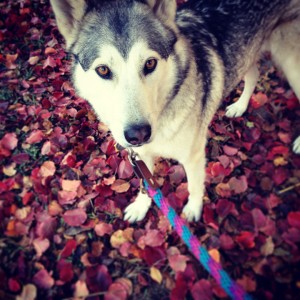It’s that manic time of year between October and Christmas, that seasonal transition where we say goodbye to summer temperatures and hello to sweater season – sometimes in just one day! As we break out the sweaters and boots, keep in mind that the transition to colder temperatures can bring seasonal issues that can pose threats to the safety of our pets. Use these safety tips to keep Fido safe and warm.
Freezing temps and snow: During inclement cold weather, be sure to keep your pets warm and safe inside. If you take them for a walk, make sure you keep the time limited. Doggie paw pads can become irritated by the cold, salt, and other chemicals that are used to treat the ice. When you bring your pets back in the house, make sure to clean and dry their feet so they don’t lick any of the salt and chemicals that may have picked up on their walk. Also, thoroughly dry them – especially their bellies and paws. Keep an eye on smaller dogs like Chihuahuas and terriers, they are especially susceptible to the cold despite their seemingly warm fur coats. Our big o’l pit bull doesn’t have enough fur to enjoy the weather without a little sweater action. Here are more cold weather tips from the SPCA
As the season changes and the temperatures drops, access to many common household items can cause serious problems if ingested by animals. Here is the list of seasonal products that the veterinarians at Pet Poison Helpline recommend you keep away from pets:
Mothballs: Lots of people recommend moth balls to keep away wild animals like squirrels and armadillos. But be aware, mothballs are extremely toxic to pets. Mothballs typically contain either paradichlorobenzene or naphthalene. Old fashioned mothballs (naphthalene) are considered more toxic, both can be deadly. Symptoms include: vomiting, severe abdominal pain, tremors, weakness, possible kidney or liver failure, and severe abnormality of your pet’s red blood cells.
Antifreeze: Antifreeze is extremely attractive to pets. It has a sweet smell and taste. As people prepare their boats, cars or cabins for winter, pets may inadvertently be exposed to antifreeze. Be aware, as little as one teaspoon in a cat or a tablespoon or two for dogs, depending on the size of animal, can be fatal. Signs of early poisoning include: acting drunk or uncoordinated, excessive thirst, and lethargy. While signs may seem to improve after eight to twelve hours, internal damage is actually worsening, and crystals develop in the kidneys, which result in acute kidney failure. Seek immediate veterinary aid for your pet. YOUR PET WILL NOT RECOVER ON HIS OR HER OWN. Time is critical as within minutes your pet will begin to experience kidney damage. Immediate treatment with an antidote is crucial.
You can prevent antifreeze poisoning by using pet friendly antifreeze in your vehicle. If your mechanic isn’t using pet-safe antifreeze ask them to special order it for you. It may cost a few dollars more but it could save animals’ lives. Here is a link to the SPCA’s pet friendly anitfreeze campaign
Mouse and Rat Poisons (Rodenticides): As you prepare to winterize your garage, cabin, or house, if you choose to use poison to address rodents, make sure to place poisonous baits in areas where your pet cannot reach them (e.g., high up on shelves, hidden behind work spaces, etc.). “Rodenticides also pose the potential for relay toxicity,” said Dr. Ahna Brutlag, assistant director of veterinary services at Pet Poison Helpline. “In other words, if your dog eats a large number of dead mice poisoned by rodenticides, they can experience secondary effects.” Because there are several different types of chemicals in mouse and rat poisons, all with different active ingredients and types of action, it is imperative to keep your pets away from all of these potentially dangerous poisons. Instead of using poison, 311 Wildlife has great humane tips to make your house unattractive to rodents and critters.
Compost bins or piles: Composting is a growing, green trend. Make sure your pets don’t have access to the compost pile. Piles of decomposing and decaying organic matter and molding food products in your backyard compost pile have the potential to contain molds which cause tremors. Even small amounts ingested can result in tremors or seizures within 30 minutes to several hours.
Mushrooms: Most mushrooms are generally non-toxic, but certain types can be very dangerous. Pet owners should check their yard frequently to get rid of any mushrooms . It is best to consider all ingestions of unidentified mushrooms as toxic until proven otherwise. If your dog has ingested a toxic mushroom, symptoms include vomiting, diarrhea, abdominal pain, depression, tremors, and seizures, with liver and kidney damage occurring later.
For additional information, check out the Pet Poison Helpline website
Most importantly, enjoy these cooler temps with your 4 legged pal. Take advantage of the cooler weather and get outside and take your dog for a walk or a hike!


